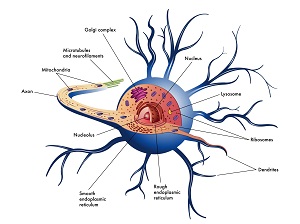16 Mar Neurons – Section 2 Intro
 Neurons: Processing Elements or Storage Cells?
Neurons: Processing Elements or Storage Cells?
In the Brains section of this blog, we examine the brain, its areas, and the types of neurons that populate the different layers of some of the brain’s areas. My posts in this segment will turn up the magnification and look a little deeper. What can be seen inside the cells? What is it that enables them to perform the functions that are most interesting to students of cybernetics? The framework for this examination is, once again, an attempt to model cognitive functions with an electronic / mechanical paradigm.
If the brain is like a garden many different areas growing different plants, then neurons are like individual blossoms, reaching out and giving life and variety to the whole.
Neurons are essential components of thought. But how do they do what they do? Unfortunately, we do not know all the answers. We can, however, look at what scientists know and what they suspect. Perhaps we can even base a set of modeling assumptions on the foundation of scientific evidence.
| Understanding Context Cross-Reference |
|---|
| Click on these Links to other posts and glossary/bibliography references |
|
|
|
| Prior Post | Next Post |
| Brains | Varieties of Nerve Cells |
| Definitions | References |
| neurons thought | Kuffler 1984 |
| neural network context | Pansky 1988 |

Some schools of thought suggest that it is not the neuron but the network that is the most critical mechanism of thought. The description of the structure and functions of the human neural network will be taken up in the next segment, “Biological Networks”. First, however, we need to know more about neurons. We will explore the shape of neurons, their components and the possible implications for imitative computing models.
This segment, and the next, build on physiological perspectives of the brain as a whole. Specifically, we here examine brain cell or neuron components. We also look at the chemical and electrical functions of cognition. The shapes of different cells are described here also. Human neural networks are the subject of the third segment of our analysis of bio brains in the context of imitating their capabilities.
| Click below to look in each Understanding Context section |
|---|








